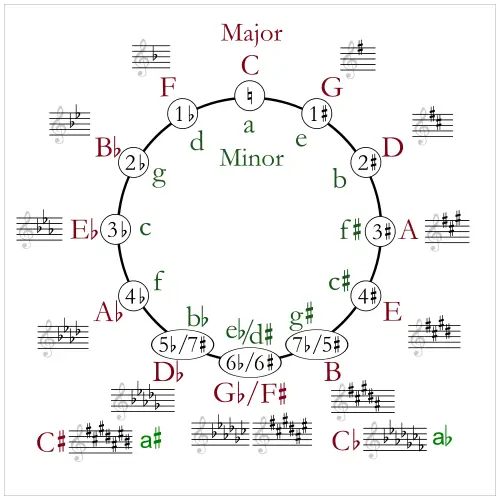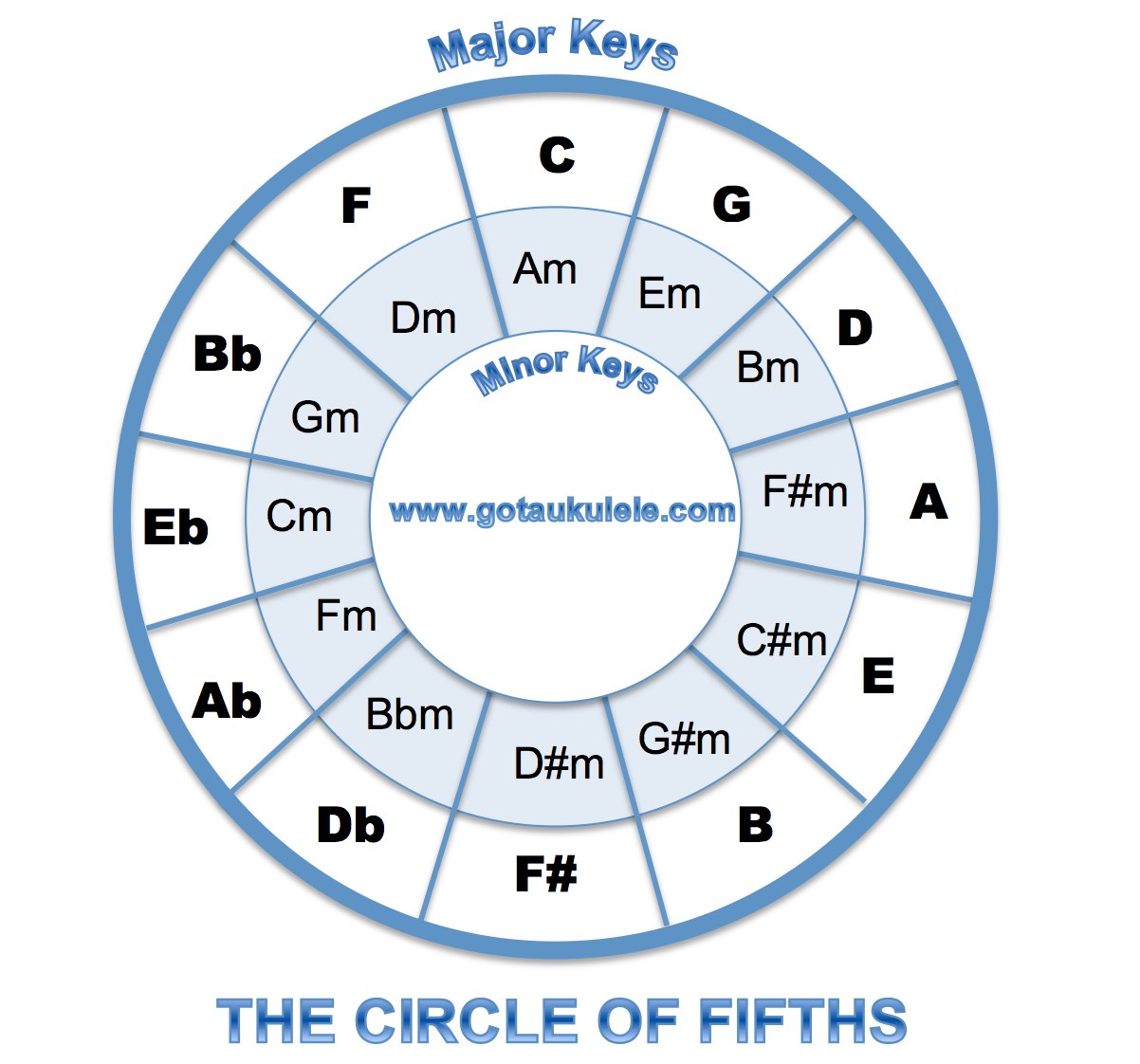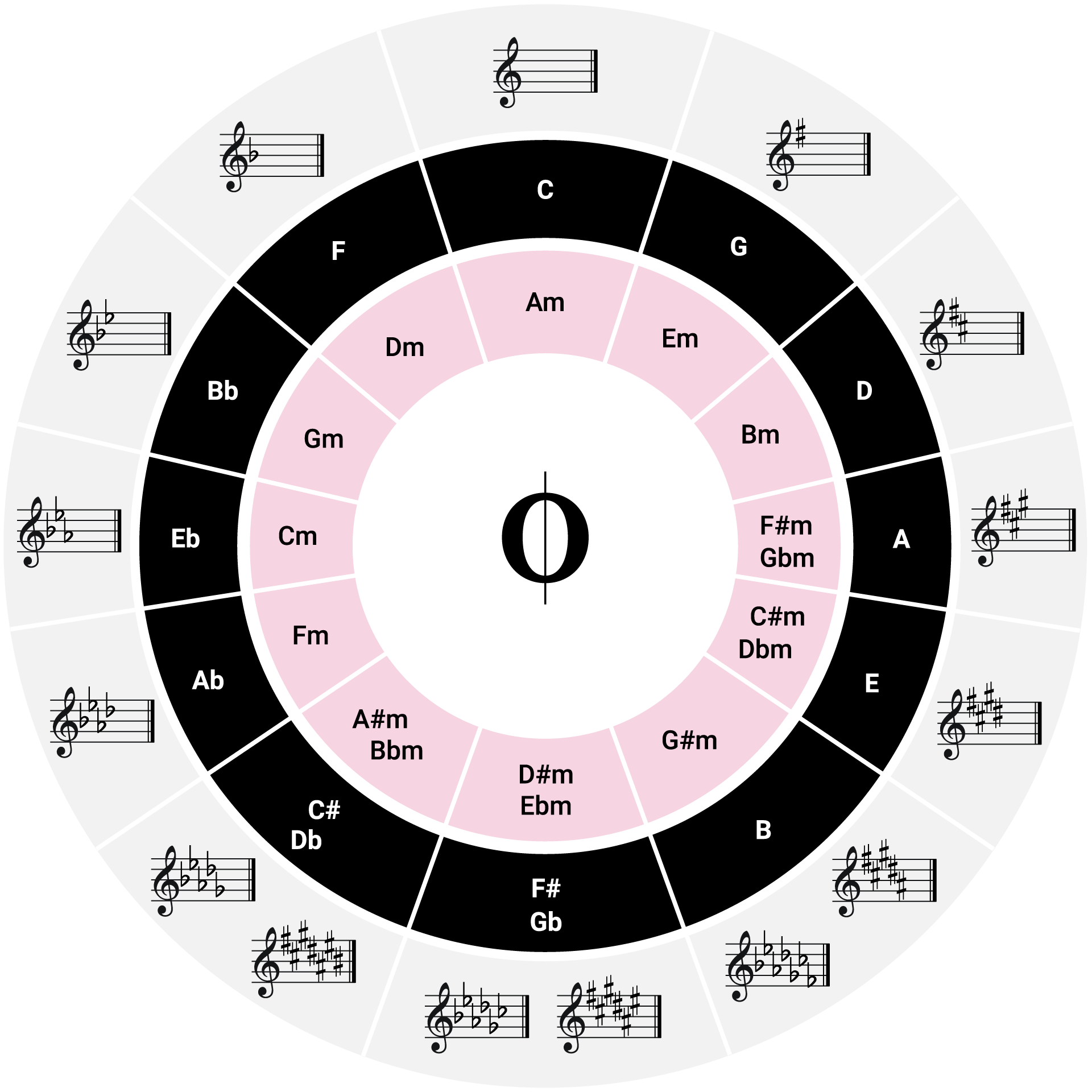HomeAboutCode ProjectseBookMerchPlaylistsContact
- Circle Of Fifths Violin Pdf
- Circle Of Fifths Pdf Piano
- Circle Of Fifths Test Pdf
- Circle Of Fifths Pdf Download
- The Ultimate Guide To The Circle Of Fifths Pdf
Circle of Fifths Poster
Circle of fifths page 1 The circle of fifths is a great visualization and reference tool to illustrate the relationships between major and relative minor keys, chords, and sharps and flats. As per the circle illustration below, there are 12 notes corresponding to the 12 numbers on a clock. The basic Circle of Fifths. C is placed at the 12 ’ position, and if you move clockwise, each successive note is a fifth (i.e. Three tones and one semi-tone higher, or if you prefer 7 semi-tones) and this is why it is called the circle of fifths. Astute members may realise that if you go anticlockwise the inter-vals are fourths. Use the Circle of Fifths Theory Worksheets to SEE how the Circle of Fifths is created. HEAR the distances between the notes on the circle. PLAY the Circle of Fifths on the piano. Step #1: On the staff, write Middle C. Using the keyboard to find the distance of a Perfect 5th, continue to write up the staff in fifths.
The circle of fifths has become a foundational tool in Western music theory. Graphically, different alterations to the circle were made by Nikolay Diletsky in the 1670s, and Johann David Heinichen in 1728, until we finally arrived at the Circle of Fifths with which we are familiar today. The circle presents a way of traversing though all 12 keys by moving through successive perfect fifths or 7 semitones (eg. C to G) in a clockwise direction and perfect fourths or 5 semitones (eg. C to F) in an anti-clockwise direction. The movement of keys in fourths and fifths are the second and third most consonant intervals besides the octaves, thus making them the most harmonious movement in Western music.
Essentially the diagram is a rich map of the 12 key signatures we have in Western music and how they relate to each other. Each key can be seen as the tonal center of the major or minor modes. It explains how adjacent keys are the most similar to each other.
F C G D A E B F# C# G# D# A# or
F C G D A E B Gb Db Ab Eb Bb
The Circle of Fifths maps onto a 12-hour clock, as described in the following table below. No key signature has both sharps and flats. Now, as you move through each key beyond C at 0 am, new sharps or flats will be added to the key. For instance, the difference between C major at 0 pm and G major at 1 pm, is that F toggles to F sharp. To get to the next key, D major at 2 pm, you toggle the C to C sharp. In the key of A at 3 pm, you toggle the G to G sharp. To become fluent with Western music, you should learn these patterns by heart, in the same way, you must learn your times' tables to do the most basic maths.
As you turn clockwise the order of flats is
F#, C#, G#, D#, A#, E# As you turn anti-lockwise the order of flats is:
Bb, Eb, Ab, Db, Gd, Cb

Here is a little tip to remember the pattern. You will notice that the pattern of sharps F-C-G-D-A-E-B appears when going clockwise from C, and the pattern of flats B-E-A-D-G-C-F appears when going counterclockwise from C. The pattern is mirror reversed when you change from a clockwise movement to an anti-clockwise movement. Major and minor keys that have the same number of either sharps or flats are considered relatives. For example, C major's relative minor is in A because C major has the exact same notes as A minor.
| Clock Position | No #/b | New Sharp/Flat | Sharps / Flats | Major Scale | Relative Minor |
|---|---|---|---|---|---|
| 0am | 0 sharps | - | - | C Major | A Minor |
| 1pm | 1 sharps | F# added | F# | G Major | E Minor |
| 2pm | 2 sharps | C# added | F# C# | D Major | B Minor |
| 3pm | 3 sharps | G# added | F# C# G# | A Major | F# Minor |
| 4pm | 4 sharps | D# added | F# C# G# D# | E Major | C# Minor |
| 5pm | 5 sharps | A# added | F# C# G# D# A# | B Major | G# Minor |
| 6pm | 6 sharps | Cb added | A# D# G# C# F# B Bb Eb Ab Db Gb Cb | Gb / F# Major | Eb Minor |
| 7pm | 5 flats | Gb added | Bb Eb Ab Db Gb | Db Major | Bb Minor |
| 8pm | 4 flats | Db added | Bb Eb Ab Db | Ab Major | F Minor |
| 9pm | 3 flats | Ab added | Bb Eb Ab | Eb Major | C Minor |
| 10pm | 2 flats | Eb added | Bb Eb | Bb Major | G Minor |
| 11pm | 1 flats | Bb added | Bb | F Major | D Minor |
How do you find the relative minor of a major key? You count 3 steps clockwise from I. So if you are in the key of C at 0am, just add 3hrs and you'll land on A at 3pm.
How do you find the perfect fifth of I? Just add 1hr on the clock. So if you are in the key of C at 0am, then go to 1pm, where the G is located.
How do you find the perfect fourth of I? If you are in C at 0am, then subtract 1hr, and move anti-clockwise by one step to 11am where F is located.
How do you find the third of I? If you are in C at 0am, then add 4hrs eg to get to 4pm, which is where E is located.
The Circle of Fifths can also be used as an analytical tool to describe the darkness and brightness of the seven chords or modes of the major scale relative to the root. As Anton Schwartz describes, the major modes gradually become darker though Lydian, Ionian, Mixolydian, Dorian, Aeolian, Phrygian and Locrian. Each of these modes of the major scale traces out seven consecutive places on the Circle of Fifths. In this way, with each move in the circle, the brightest note is replaced with the next darkest note relative to the root note. Thus, relative to C, the notes F#, C, Bb, Eb, Ab, Db, Gb become increasingly darker sounding. In the paper Perception and Familiarity of Diatonic Modes by Dephane Tan & David Temperley, I discovered this nice graphic showing the circle of fifths in a linear form with the intervals and notes mapped out as in fifths. The graphic represents the modes of the major scale on this linear line of fifths. You can of course also imagine this on the Circle of Fifths.
 Ethan Hein says that one can imagine the seven-tone major scale and its modes as a series of toggles. Each note beside the root can be flat/sharp or natural. If you toggle a natural note (except the 4th), you produce a scale with a darker feeling, and if you toggle a flat note, you give the scale a brighter feeling. For example, relative to the major scales with the toggles on 1, 2, 3, 4, 5, 7, the minor scale sounds darker, with its intervals toggled to 1, 2, b3, 4, 5, b6, b7. The Lydian scale with the intervals 1, 2, 3, #4, 5, 7 sounds even brighter than the major scale.
Ethan Hein says that one can imagine the seven-tone major scale and its modes as a series of toggles. Each note beside the root can be flat/sharp or natural. If you toggle a natural note (except the 4th), you produce a scale with a darker feeling, and if you toggle a flat note, you give the scale a brighter feeling. For example, relative to the major scales with the toggles on 1, 2, 3, 4, 5, 7, the minor scale sounds darker, with its intervals toggled to 1, 2, b3, 4, 5, b6, b7. The Lydian scale with the intervals 1, 2, 3, #4, 5, 7 sounds even brighter than the major scale. | Scale Interval Toggles | Brightness | ||||||
|---|---|---|---|---|---|---|---|
| 1 | 2 | 3 | #4 | 5 | 6 | 7 | Brightest Intervals |
| 1 | b2 | b3 | 4 | b5 | b6 | b7 | Darkest Intervals |
| 2 | 6 | 4 | 1 | 7 | 5 | 3 | Rank |
| Lydian | Brightness | ||||||
|---|---|---|---|---|---|---|---|
| 1 | 2 | 3 | #4 | 5 | 6 | 7 | Lydian |
| b2 | b3 | 4 | b5 | b6 | b7 | ||
| Major | Brightness | ||||||
|---|---|---|---|---|---|---|---|
| 1 | 2 | 3 | #4 | 5 | 6 | 7 | Major |
| b2 | b3 | 4 | b5 | b6 | b7 | ||
| Minor | Brightness | ||||||
|---|---|---|---|---|---|---|---|
| 1 | 2 | 3 | #4 | 5 | 6 | 7 | Minor |
| b2 | b3 | 4 | b5 | b6 | b7 | ||
| Modes of the Major Scale and their Brightness | |||||||
|---|---|---|---|---|---|---|---|
| No of #/b | Mode | Modes | Intervals | Notes | Sharps / Flats | Major Scale | Brightness |
| 1 | IV | C Lydian | 1 2 3 #4 5 6 7 | C D E F# G A B | F# | G Major | Brighest |
| 0 | I | C Ionian | 1 2 3 4 5 6 7 | C D E F G A B | - | C Major | |
| 1 | V | C Mixolydian | 1 2 3 4 5 6 b7 | C D E F G A Bb | Bb | F Major | |
| 2 | ii | C Dorian | 1 2 b3 4 5 6 b7 | C D Eb F G A Bb | Bb Eb | Bb Major | Middle |
| 3 | vi | C Aeolian | 1 2 b3 4 5 b6 b7 | C D Eb F G Ab Bb | Bb Eb Ab | Eb Major | |
| 4 | iii | C Phrygian | 1 b2 b3 4 5 b6 b7 | C Db Eb F G Ab Bb | Bb Eb Ab Db | Ab Major | |
| 5 | vii | C Locrian | 1 b2 b3 4 b5 b6 b7 | C Db Eb F Gb Ab Bb | Bb Eb Ab Db Gb | Db Major | Darkest |
Circle Of Fifths Violin Pdf
Looking at the difference between the brightest mode (Lydian) and the darkest mode (Locrian), the Lydian mode consist of a maximum of major and augmented steps (M2, M3, A4, P5, M6, M7) and the Locrian mode consist of a maximum of minor and diminished steps (m2, m3, P4, dim5, m6, m7). Thus the darkness-consonance logic of the Circle of Fifths coincides well with our perception that major chords are more consonant than minor chords and that diminished chords are more dissonant than minor chords. For more details see The Psychophysics of Harmony Perception: Harmony is a Three-Tone Phenomenon. As you can see, there is a lot of wisdom packed into the Circle of Fifths which was fashioned on the major scale and its modes. Unfortunately, trying to map the logic of the Circle of Fifths on to other scales outside of the major modes is not as straightforward. For example, the Harmonic Minor and the Dorian mode both have an equal number of flats, but do not sound equally dark.
Circle Of Fifths Pdf Piano
1 2 b3 4 5 b6 7 Harmonic Minor
1 2 b3 4 5 6 b7 Dorian
Circle Of Fifths Test Pdf
 It is perhaps these kinds of investigations into the possible colours found in harmony which lead jazz composer George Russell to explore the 'Lydian Chromatic Concept of Tonal Organization' based on the tonal gravity of the Lydian mode. Finally, for the mathematically minded, the history of the early versions of the circle of fifths is interesting. In the sixth century, B.C. Pythagoras developed the Pythagorean Circle to deduce how to space the intervals using successive perfect fifths with a ratio of 3/2 which was deemed as the most consonant interval after the octave with a ratio of 2/1. According to the Greeks, a series of 12 perfect fifths should arrive back at the same pitch, albeit 7 perfect octaves away, however, it is mathematically not possible to do this using simple ratios.
It is perhaps these kinds of investigations into the possible colours found in harmony which lead jazz composer George Russell to explore the 'Lydian Chromatic Concept of Tonal Organization' based on the tonal gravity of the Lydian mode. Finally, for the mathematically minded, the history of the early versions of the circle of fifths is interesting. In the sixth century, B.C. Pythagoras developed the Pythagorean Circle to deduce how to space the intervals using successive perfect fifths with a ratio of 3/2 which was deemed as the most consonant interval after the octave with a ratio of 2/1. According to the Greeks, a series of 12 perfect fifths should arrive back at the same pitch, albeit 7 perfect octaves away, however, it is mathematically not possible to do this using simple ratios. Circle Of Fifths Pdf Download
The Ultimate Guide To The Circle Of Fifths Pdf
In Pythagorean tuning the ratio used to tune fifths is rp = 3/2 = 1.5, whereas today's modern equal temperament uses the 12th root of 2^7 as its ratio re to calculate the fifth (7th semitone) = 2^(7/12) = 1.498
rp= 3/2 = 1.5
re = 12th sqrt(128) = 1.498307
Using the circle of fifths rp ratio multiplying 3/2 with itself twelve times = (3/2)^12 = 531441/4096 = 128 + 3057/4096 whereas the mathematically correct re ratio 2^(7/12) to the power of 12 = (2^(7/12))^12 = 2^7 = 128. We call the difference between these two tuning systems the Pythagorean comma.